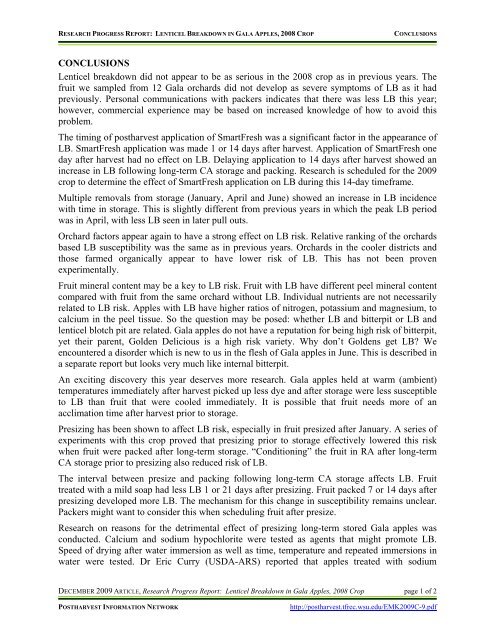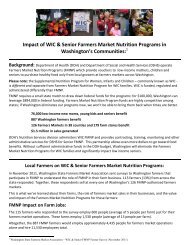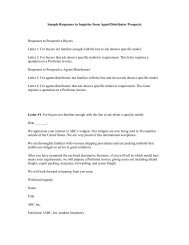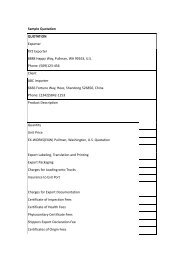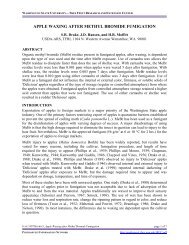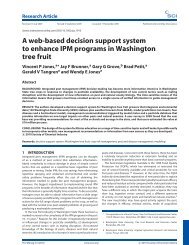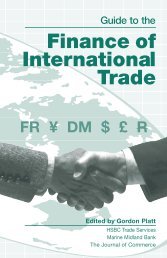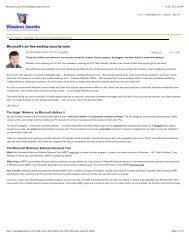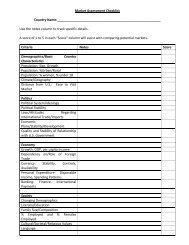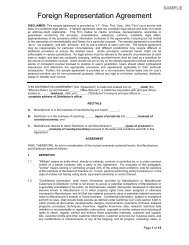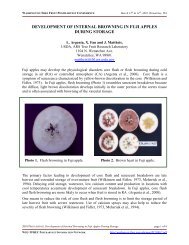Conclusion - Postharvest Information Network
Conclusion - Postharvest Information Network
Conclusion - Postharvest Information Network
Create successful ePaper yourself
Turn your PDF publications into a flip-book with our unique Google optimized e-Paper software.
RESEARCH PROGRESS REPORT: LENTICEL BREAKDOWN IN GALA APPLES, 2008 CROPCONCLUSIONSCONCLUSIONSLenticel breakdown did not appear to be as serious in the 2008 crop as in previous years. Thefruit we sampled from 12 Gala orchards did not develop as severe symptoms of LB as it hadpreviously. Personal communications with packers indicates that there was less LB this year;however, commercial experience may be based on increased knowledge of how to avoid thisproblem.The timing of postharvest application of SmartFresh was a significant factor in the appearance ofLB. SmartFresh application was made 1 or 14 days after harvest. Application of SmartFresh oneday after harvest had no effect on LB. Delaying application to 14 days after harvest showed anincrease in LB following long-term CA storage and packing. Research is scheduled for the 2009crop to determine the effect of SmartFresh application on LB during this 14-day timeframe.Multiple removals from storage (January, April and June) showed an increase in LB incidencewith time in storage. This is slightly different from previous years in which the peak LB periodwas in April, with less LB seen in later pull outs.Orchard factors appear again to have a strong effect on LB risk. Relative ranking of the orchardsbased LB susceptibility was the same as in previous years. Orchards in the cooler districts andthose farmed organically appear to have lower risk of LB. This has not been provenexperimentally.Fruit mineral content may be a key to LB risk. Fruit with LB have different peel mineral contentcompared with fruit from the same orchard without LB. Individual nutrients are not necessarilyrelated to LB risk. Apples with LB have higher ratios of nitrogen, potassium and magnesium, tocalcium in the peel tissue. So the question may be posed: whether LB and bitterpit or LB andlenticel blotch pit are related. Gala apples do not have a reputation for being high risk of bitterpit,yet their parent, Golden Delicious is a high risk variety. Why don’t Goldens get LB? Weencountered a disorder which is new to us in the flesh of Gala apples in June. This is described ina separate report but looks very much like internal bitterpit.An exciting discovery this year deserves more research. Gala apples held at warm (ambient)temperatures immediately after harvest picked up less dye and after storage were less susceptibleto LB than fruit that were cooled immediately. It is possible that fruit needs more of anacclimation time after harvest prior to storage.Presizing has been shown to affect LB risk, especially in fruit presized after January. A series ofexperiments with this crop proved that presizing prior to storage effectively lowered this riskwhen fruit were packed after long-term storage. “Conditioning” the fruit in RA after long-termCA storage prior to presizing also reduced risk of LB.The interval between presize and packing following long-term CA storage affects LB. Fruittreated with a mild soap had less LB 1 or 21 days after presizing. Fruit packed 7 or 14 days afterpresizing developed more LB. The mechanism for this change in susceptibility remains unclear.Packers might want to consider this when scheduling fruit after presize.Research on reasons for the detrimental effect of presizing long-term stored Gala apples wasconducted. Calcium and sodium hypochlorite were tested as agents that might promote LB.Speed of drying after water immersion as well as time, temperature and repeated immersions inwater were tested. Dr Eric Curry (USDA-ARS) reported that apples treated with sodiumDECEMBER 2009 ARTICLE, Research Progress Report: Lenticel Breakdown in Gala Apples, 2008 Crop page 1 of 2POSTHARVEST INFORMATION NETWORKhttp://postharvest.tfrec.wsu.edu/EMK2009C-9.pdf
RESEARCH PROGRESS REPORT: LENTICEL BREAKDOWN IN GALA APPLES, 2008 CROPCONCLUSIONShypochlorite prior to storage developed skin damage while in storage. Our findings have notshown that fruit is highly susceptible to damage from reasonable levels of sodium hypochloritewhen applied after storage. Risk of damage is reduced when an adequate rinse is utilized.The information obtained for the hypochlorite, water immersion and drying tests is not asvaluable as I would like in understanding LB due to a number of factors. For one, this year welearned that fruit which has been ‘conditioned’ in RA after CA storage develops less LB thanfruit directly out of storage. The fruit we utilized in this work had been conditioned anddeveloped very little LB. We would like to repeat this work with susceptible fruit immediatelyout of storage.Washington packers have seen less economic damage from LB than in the past for a number ofreasons; among them is the involvement of AgroFresh in sponsoring research. Thank you.DECEMBER 2009 ARTICLE, Research Progress Report: Lenticel Breakdown in Gala Apples, 2008 Crop page 2 of 2POSTHARVEST INFORMATION NETWORKhttp://postharvest.tfrec.wsu.edu/EMK2009C-9.pdf


